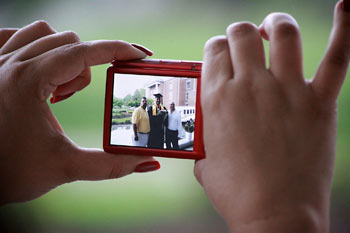

 Taking a photo with a digital camera
Taking a photo with a digital cameraSince the 1990s, digital cameras have become more and more common—and also more affordable. Because of this, it's now easier than ever to get started with photography. Luckily, you don't need to buy a professional-level camera to get good results. The most important factor is the skill of the photographer. In this tutorial, we'll show you how to use lighting, composition, and your camera's settings to take better digital photos—no matter what kind of camera you have.
There are many things you can do with a digital camera. Here are just a few examples:

For more ideas of things you can do with a digital camera, read our article on 10 Everyday Uses for Your Phone's Camera.
If you're shopping for a digital camera, the number of choices can be overwhelming. However, if you can narrow your search to a specific price range or type of camera, then it may make your choice much easier. In addition, many cameras have special features such as red-eye correction and anti-blink, so you may want to think about which features are important to you.
Most cameras can be grouped into four main types: digital SLR (or DSLR), point-and-shoot, bridge cameras, and camera phones. Each type has advantages and disadvantages, and some types are more expensive than others. To narrow down your search, try to determine which of these types will best fit your needs.
View the infographic to learn about the different types of digital cameras available.
Digital cameras often have special features designed to help you take better photos. Depending on what types of photos you want to take, some of these features can be quite useful. Below are some things you may want to look for:
 Viewing some of the features in the camera's menus
Viewing some of the features in the camera's menus
Keep in mind that higher-end cameras (such as DSLRs) are less likely to have some of these features. For those cameras, you'll have to rely more on your own skill, as well as post-processing with Photoshop or a similar program. For everyday snapshots, the convenience of point-and-shoot cameras often makes them a better choice.
 An SDHC card
An SDHC cardMost digital cameras store photos on a separate memory card, such as a Secure Digital, SDHC, microSD, or CompactFlash card. These cards usually have several gigabytes of storage space, and the exact number of photos they can hold will vary depending on the resolution and file format of the photos. You may need to purchase a memory card separately, and it's important to choose a card that is compatible with your camera. You can find this information in your camera's manual, on the outside of the box, or online.
Generally, you'll want to use the memory card as temporary storage until you transfer your photos to your computer. You can then delete the photos from the memory card so you'll have plenty of space for your next photo shoot.
Generally, cameras use rechargeable lithium-ion battery packs, although some can use AA batteries. The battery pack is usually included with your camera, but you may want to buy an extra one in case the battery runs out while you're shooting. Make sure to buy a battery pack that is designed to work with your camera.
Your camera will also come with a charger you can use with your battery. It's a good idea to recharge the battery overnight so you'll be ready to take photos the next day.
/en/digitalphotography/getting-to-know-your-camera/content/